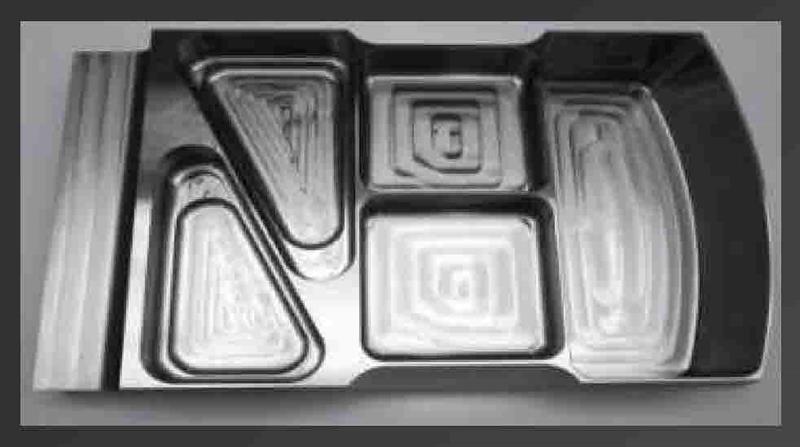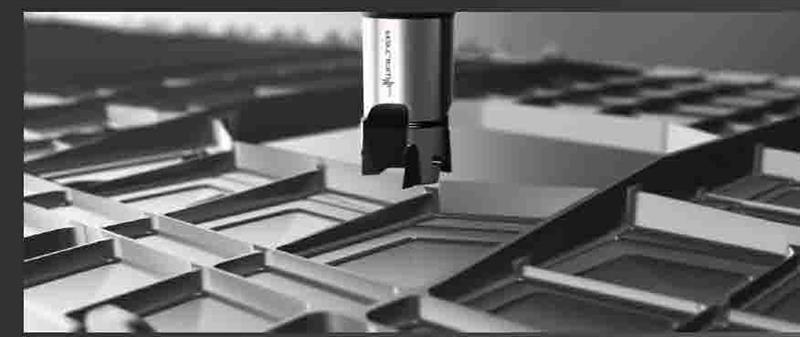With about 40% of sales going to products launched in the last five years, a large part of the corporate investment of toolmaker Walter (01527 839450) is in research and development.
The German company’s global competence centre in Tübingen, Germany, handles applications for the manufacturing market segments of aerospace, energy and transportation (taking in road and rail).
Developing a new tool involves drawing-board designs, manufacture, in-house and customer testing and development, both of an insert and a toolholder. The length of the process varies between six months and three years. After development, the product is rolled out to local engineering and application teams around the world – including in the UK – using internal systems such as its Microsoft SharePoint database.
Jim Dale, aerospace component manager at Walter, points out that innovations do not start and end in isolation. “The driver of the tool design is the machining strategy. New toolpath strategies are coming in, in the form of CAM operations, or from customers. We have to be at the forefront of learning to make sure that tooling development is right for them,” he states. The tool’s performance depends as much on the machining path strategy as on the tool design, and Dale gave a few examples of recent products, and their drivers, at a Sheffield aerospace conference in November 2015.
One catalyst in the recent development of a titanium milling cutter was an industry challenge issued by Boeing concerning aircraft structural parts. The aerospace giant said that current removal rates for long-edge milling of titanium is 10.7 in³/min; it laid down its requirement for rates 60% faster: 16.7 in³/min.
Walter’s solution was a new generation porcupine cutter: 80 mm diameter, cutting depth 127 mm, incorporating inserts arranged along six flutes having a 27° helix, an integral ISO 50 shank and featuring internal cooling. There are 12 inserts per flute; 11 of them have four cutting edges, and their top and bottom flanks interlock with each other. At the tool’s lowest extremity is a single lead insert with only two cutting edges. Its rear side features two pins that locate into the tool body, to stabilise both themselves, as they do the heavy work, and lock in the rest of the inserts.
This new M3255 cutter, launching as a standard product this month in a variety of sizes, offered in the Boeing test a width of cut (Ae) of 25.4, depth of cut (Ap) of 76.2 mm, cutting speed (Vc) of 45 m/min and feed (Vf) of 163 m/min, or 0.15 mm/tooth. These parameters combine to produce, most importantly, an overall metal removal rate of 23.7 in³/min (388.4 cm³/min), beating Boeing’s benchmark figure by more than 100%.

Walter worked with the AMRC to use the new cutter and inserts in a trochoidal milling strategy to cut a sample part
Also part of the development is a new WSM45X insert coating: at 7 micron thick, it is the first thin-film coating deposited in a chemical vapour deposition (CVD) process over the carbide substrate. The thinness of the coating helps preserve the sharp cutting edge needed for titanium, whilst offering additional heat resistance. Finally, it also features the TigerTec Silver post treatment to smoothen the surface finish to improve chip flow.
Not only does Walter develop the tool, but it also engineers its cutting conditions and other process factors so that the tool can work at optimum efficiency. Take, for example, the popular trochoidal milling toolpath strategy, in which tool contact in and out of the material is optimised, ultimately yielding higher metal removal rates by using more of the tool’s length. Now it seems every CAM provider offers a trochoidal toolpath; in this particular case Walter used a Catia (024 7685 7400) concentric toolpath. “We work with many new dynamic toolpath strategies,” Dale says.
He goes on to explain how Walter collaborated with the Advanced Manufacturing Research Centre with Boeing, located on the Advanced Manufacturing Park near Sheffield, to make a finished generic part, using the toolpath strategy for a rough pocketing process, and employing the M3255 porcupine cutter. AMRC’s Starrag STC 1250 (0121 359 3637) machining centre, for example, rough cut one pocket 250 by 120 mm by 74 mm deep in 14 minutes, using a 50 mm diameter, five-flute cutter at a feed of 0.15 mm/tooth for a 30 mm width of cut.
A third innovation was developing a cutter to withstand the rigours of pocketing aerospace wing rib parts. Walter developed a ramping tool around a high performance pocketing machining strategy that involves ramping into the pockets at high speed. Using a ramping tool removes the need to pre-drill a hole to allow acess for a shoulder- or face-mill cutter, explains Dale: “If you have the right machine tool base, you can achieve over 8.5-10 l/min removal rate; that’s an industry benchmark. But it is dependent on the machine tool and its drives. What you need for maximum material removal in ramping tools is high power machines.” He suggests a minimum spindle power of 120-150 kW for high performance milling.

Ramping cutter cuts pockets into aeroplane wing ribs
This new M2131, launched last year, replaces Walter’s original ramping cutter. The project responded to another industry challenge, in fact, this time from Korea Aerospace Industries (KAI). A change of material from aluminium 7000 or 2000 to aluminium lithium alloy 2050 for wing ribs had hurt tool life, and hence the profitability of the machining process. Whereas tool life on the older materials ranged from 200-300 minutes, on the new material, which also has lower density, greater elasticity and stiffness, it was only half an hour.
Here the most important technical issue turned out to be surface finish. Explains Dale: “In aluminium machining, it is critical that the surface is as smooth as possible, because aluminium tends to cold-weld and sticks to globules or small spots of roughness on the coatings, and that’s what causes the downturn in tool life.”
Walter applied a new physical vapour deposition (PVD) technology to create a very dense and smooth TiAlN coating of 2 micron thickness. This new coating process creates a smoother surface that is heat resistant and prevents cold welding. Walter’s resulting new WNN15 grade insert for the ramping tool improved tool life in lithium aluminium to 120 minutes.
Dale’s final example again finds Walter working with technical partners, developing a new approach to cutting aluminium wing structures, in which many similar features repeat in various combinations in hundreds of parts: pocketing, for example, or thin-walled structures or freestanding walls. “We have made these features part of a generic machining solution with a feature-based approach,” he says, which is new for Walter.
Offers Dale: “It gives people a solution: if you have this type of feature, you can machine it this way. Then you can train applications engineers to use the tools with new machining strategies, whilst making sure that the work stays within the capabilities of the machine. This is all part of what we’d say is our component solution. Instead of just selling the tool, we’re selling engineering competence.”This article was originally published in the March 2016 Machinery aerospace supplement.










